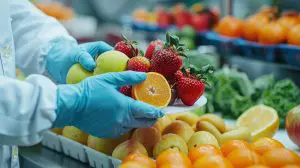If your activity involves food manufacturing or importing food, you follow the Codex HACCP guidelines. Adopted in 1969, the General Principles of Food Hygiene have recently been revised to reflect the current understanding of food safety risks. The document comprises two parts: the first section describes Good Hygiene Practices for primary food producers and post-farm manufacturers and processors. The second part covers the principles of Hazard Analysis and Critical Control Points (HACCP) and guidelines for its application.
HACCP is a systematic and risk-based approach to food safety management. The HACCP methodology is designed to control food safety risks that may impact consumers. HACCP counts five preliminary steps and 7 Codex principles for a total of 12 steps. As part of a food safety plan for food manufacturing or food importation, three categories of food safety hazards must be considered, rated for risk level and the likelihood of occurrence, and then reduced to safe levels or eliminated. Three categories of hazards are considered – biological, chemical, and physical. While physical hazards are not responsible for the bulk of food safety recalls in North America, all reasonable means should be taken to eliminate any risks of choking and injury in adults and children.
According to the US FDA, “physical hazards are broadly classified as hard/sharp physical hazards and choking hazards. It is understood that both categories can cause injury to the consumer. These injuries may include dental damage, laceration of the mouth or throat, laceration or perforation of the intestine, and choking, which may even lead to death. Because physical hazards cover a broad range of contaminants, such as glass, metal, plastic, wood, and stones, such contamination can occur throughout the processing facility, including the receiving dock for ingredients and supplies.”
In addition to food hazards, the US FDA, under the Code of Federal Regulations, Title 21 – Part 117 Subpart B, has established maximum levels of natural or unavoidable defects in foods for human use that present no health hazard. Food defects or “filth” is defined as “any objectionable matter contributed by animal contamination of a food product, such as insect, rodent or bird matter, or any other objectionable matter contributed by unsanitary conditions.”
The CGMP (Human Food) regulations stipulate that a “manufacturer, processor, packer, and holder of food must at all times utilize quality control operations that reduce natural or unavoidable defects to the lowest level currently feasible.” Furthermore, “the mixing of a food containing defects at levels that render that food adulterated with another lot of food is not permitted and renders the final food adulterated, regardless of the defect level of the final food.”
Companies that import or source agricultural products such as raw spices, produce, fresh fruits, and vegetables may consult the US FDA’s Defect Levels Handbook for reference. Imported spices, for instance, have been the subject of many scientific reports leading to guidance by the US FDA (published 2013). According to Scientific American (2014), “roughly 12 percent of spice imports, which make up the bulk of the U.S. supply, exceeded federal limits on the “maximum levels of natural or unavoidable defects,” such as insect body parts and animal hair.” Past enforcement actions have been reported for soy processing and the repackaging of rice.
USDA/FSIS Recalls for the last two years (2022- 2023 YTD) identify fewer than 20 food recalls regarding product contamination. Foreign materials found in marketed food included plastic fibre, rubber, hard plastic pieces, cardboard, blue string, extraneous materials, copper wire pieces, white neoprene type material, wire-like metal pieces, metal pieces, and mirror-like material.
A similar search for 2023 YTD from the FDA FSMA dashboards (Recalls) identified 60+ recalls for foreign material. The following materials were found in food: ink pen pieces, filth in flour, choking hazard, deer droppings in leafy greens, metal, glass, plastic, rubber, wood, rodent parts, brush brittles, beetles, and fish bones.
Regulatory standards for physical hazards in human food
In May 2005, the US FDA revised a Compliance Policy Guide (CPG) – CPG Sec 555.425 Foods, Adulteration Involving Hard or Sharp Foreign Objects – to address hard or sharp foreign objects in food that may cause serious injury. The initial guidance dates back to 1999 when the US FDA Health Hazard Evaluation Board analyzed nearly 200 reports of food contamination with foreign objects over a 25-year period. From this review, the board issued the regulatory action guidance that physical hazards smaller than 7 mm in size rarely cause injuries except in special risk groups (surgery patients, the elderly, and infants). The CPG was revised in 2005 to cover special-risk populations and foods that do not require further processing before consumption.
- Ready-to-eat (RTE) foods containing a hard or sharp foreign object measuring 7 mm to 25 mm in length would be considered “adulterated” and subject to recall.
- If a hard or sharp foreign object less than 7 mm in length is found in food consumed by a special-risk individual, or if a large piece of foreign material (over 25 mm) is found in RTE food, it would be considered unfit for human consumption.
FSIS/USDA Regulatory guidance
Directive 7310.5 – Presence of Foreign Material in Meat or Poultry Products (2003) – provides guidance to food inspectors. Monitoring of physical hazards in meat and poultry is carried out by managing the food facility’s HACCP plan. The USDA/FSIS prescribes no standard regarding the size of sharp and hard physical extraneous hazards in meat and poultry products.
Regulatory Guidance in Canada
Health Canada considers that “foreign objects, 2.0 mm or greater in size, present a health risk to adults. For food consumed by infants, any size of hazardous material may be a risk.” The hazard may be further evaluated based on other criteria such as shape, hardness, material type, contamination source, or target consumer groups.
Food processors, manufacturers, and importers manage physical hazard contamination in food by applying Good Manufacturing Practices (GMP) and HACCP principles. The verification of HACCP plans ensures that food safety risks are properly identified and controlled. A combination of visual inspection activities and technologies such as optical sorting, X-ray machines, magnets/metal detectors, sifters, and filtration equipment are used to remove extraneous hazardous materials in food.
Filth Analysis
With stricter food safety regulations and an increased incidence of recalls and foodborne illnesses, the international food sector, including food importers, has been seeking filth analysis services. Laboratories can now analyze for filth contaminants in food, including rodent hairs, insect fragments, and other extraneous material. This is achieved using visual examination, microscopy, and sieve analysis in keeping with accepted AOAC methods and other standards.
References
CPG Sec. 555.425 Foods, Adulteration Involving hard or Sharp Foreign Objects
FDA Defect Action Level Handbook
Reference Database for Hazard Identification – Physical Hazards (CFIA, Canada)
Hazard Analysis and Risk-Based Preventive Controls for Human Food: Draft Guidance for Industry
Sirocco Food + Wine Consulting provides GMP, HACCP, SQF training and Consulting Services. Our team of Food Safety professionals (credentials include SQF Practitioner, Certified SQF Consultant and Trainer, Lead HACCP instructor, Lead FSPCA Instructor for Human Food) assist you in the development and implementation of food safety plans, food importer plans, and management systems towards food safety certification. Contact us to learn more.





